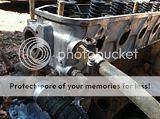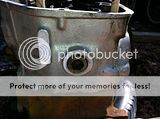Oh Wow, oh wow oh wow! That econo piston is the answer! Bookworm007, you da man!
Silvolite has 'em listed too
http://www.kb-silvolite.com/silv-o-lite ... s&S_id=552
In one Falcon swoop you solved
1.an 11 year old problem I had with my X-flow, and
2. have made a 221 stroker from a 200 possible and
3. Have fixed
all the US 250 problems and made them strengths. L/R, the lambda length of rod to throw ratio, a problem with all Ford sixes except the Aussie 3.3 from 1971 on has been fixed. 1.5:1 where the rod is 5.88" and the stroke is 3.91" is not a good ratio for reving past the peak power curve.The US 200's has 1.5:1 too, with 4.71 to 3.126" and all 250's on both sides of the Pacific rim suffer an asthmatic halt past there power peak because of this ratio. Long rods unload the pistons at high rpm, reducing frictional losses under hard loads. The C/R problem with big stroke sixes from 221 to 250 has also been fixed.
What a Good choice, best one I've seen as this is the hardest nut to crack since the thin wall 250 has a huge deck problem that cannot be solved by decking! In my opinion, the decking of a block that has led its life with with that 103 thou short fall is a bad idea, it hairline cracks about the front head studs and on an engine that needs longer rods, why would you ever deck the block? The piston, mated to a longer, bomb proof 300 6.21" Ford rod with a nice brass bush, or earlier pre 69 rods with there stock 0.912 wrist pins would be ideal to bush down to 0.905". 1.31 compression height, 6.21" rod, 1.955" throw 3.91" stoke crank, perfect o deck, and a nice big dish to suit, this is a magic, or rather, anointed idea.
The 89-93 GM 3300 (LG7) engines were skipped because of the port EFI GM 3800 engines power and economy excellence. I spent 125 000 miles behind a GM 3800 Holden, an engine which made 177 hp in non emissions NZ spec, a 17 second flat quarter mile, 130 mph top speed, 25 US miles per gallon on coarse tar seal, and never less than 19 miles per gallon US ABSOLUTELY THRASHED. Our State Highway Ride Meter, housed in a 1993 VP Holden Commodore, weighed in at 3500 pounds with 200 pounds of steel over the back axle. Stock, with only 2750 pounds, and 700 r-4 auto could dip in to a 15.8 second quarter, and get 30 US mpg.
With a cam, and piston changes, unsupercharged Formula Holden GM 3800's made 315 hp at 6500 rpm with stock injection and ignition.
On the little 3300, the deck was shaved back to the old 215 Buick size. Pistons were 100 thou undersize at 3.700", but just fine for stock 4.0 Liter Rover strokers. When Rover rehashed the 215, they had a funny, un American policy of not supplying +10/+20/+30/+40/+50/+60 over size pistons in 3.5, 4.0 and 4.6 blocks. So Buick 300 and 340 pistons get used all the time. Everyone used to shove Aussie 1973-1975 4.4 liter P76 or Buick 300 cranks in this sucker, and then have to find some 229/305 forged pistons which were 3.736" stock...just about the limit of the stock liner and often a problem unless the block is resleaved.
Back before I joined Ford Six, I had a special block made up. My 229 cubic inch X-flow Falcon engine runs a cold run welded cast iron XT Falcon 221 crank (the 1968 to 1970 221 ran 200 Falcon main bearings, but the post 1971 non cross flow and crossflow blocks were all a similar to US 250 bearing size, and also ran the small 200 Ford crank pilot, which was 3.4" diameter rather than 250/240/300/Small Block Ford 3.625" crank flange).
For pistons, some 12cc dish 3.736" 305 and 229 TRW forged pistons which have two different part numbers but are the same piston. Each has a lot of meat in it as a forged piston, with 110 thou depth and an irregular shaped trough of 3.1" diameter on its longest side. Enough to take 110 thou or more off in a lathe. The 1971-1993 3.3 Liter Aussie rods were all 6.27" and are fixed to the 0.927" Chevy rod after a 15 thou hone out from the nominal 0.912 wrist pin. Then the pistons were decked to suit the 9.387" deck register our Aussie ohv 200/250 sixes had from 1971-1993. I had to add a much taller 62 thou head gasket, as the pistons had to be shaved right down a massive 140 thou to 1.39". 1.39 compression height, 6.27" rod, 1.73" throw 3.46" stoke crank, perfect o deck, but the stock nice big Chevy small block dish was totally gone, and the stock alloy head X-flow chambers are 53 cc, so compression was 10.75:1 to suit propane. It solved the L/R ratio problem, but then I lost heart, and as I was looking at supercharging, there was no way to get the C/R down unless I added a 140 thou plate and found another set of TRW Forged pistons as I'd already cut them down. I'd used the first four from the right bank from the 305 forging and the two of the right bank from the 229. The pistons have a 62.5 thou thrust left to right, and the V6 ones were designed for the semi even fire 229, which was designed to run offset conrods. The dish is biased, so you can't just get six the same. Long story short, my combo only works for a high compression engine on NZ 98 octane, and its layed dormant in my basement because of that reason.
Funny thing is that 1.39" is about the deck height of the 1988-1992 3.612 and 1993-1999 3.622" 3939 and 3984 cc Aussie I6 OHC pistons. If you sleave down to 3.622 from a 3.7" or 3.72" over bore, you can use the 3984 1993-1999 pistons at 1.39" or the 1.1629" 1999 to date DOHC pistons from engines that made anythoing from 197 hp right on up to a factory 422 hp in the low compression turbo version. There was a cross over when both OHV x-flow and OHC engines were made on the same tooling, but the OHC ran a 9.22" deck, 160 thou lower than the stock ohv block. The US 250 is 9.469". This means that you have a whole heap of options. Oh, and 3.622" is the Subaru WRX STi 2000 cc piston size, and using Subaru forged pistons and rings with a Chevy 6" rod made 1500 hp possible from a Nispro engine back in 2005.
Other pistons to consider?
Well, the Chev 250 piston at 3.685" is actually either one of the 60 thou over Holden 202 L6 pistons or a similar variant found in the 253 Holden with a bigger wrist pin. Stock bore is 3.625 for both engine, compression height is 1.75", and wrist pin is 0.866 or 0.927". The Holden 202 piston is also made in 80 thou over 3.705" versions if you do your homework.The good versions of these are okay up to 7000 rpm all day if they are XU1 GTR spec on the 202, or 6800 rpm for Commodore Challange part numbers. The ft per second on the 3.25" stroke 202 and 3.0625" stroke 253 are reduced when they are put into a US 250, as its stroke is longer, but each is okay to at least 78% of that 7000 rpm figure. A 250 reving to 5818 rpm with 202 pistons isn't out of the question, or 5305 rpm using the 253 pistons.
See the 253 Holden piston at
http://www.kb-silvolite.com/silv-o-lite ... s&S_id=724 , wrongly listed as GM 250.
It lookes like there are a lot of young bucks doing dodgey data management. This piston is actually a 253 piston which will fit a stock bore plateau honed to 3.685". It is an excellent piston, hacks 6800 rpm and 290 hp and 150 mph in the Commodore Challenge using 4.2 liter 1978-1984 VB/VC/VH Vee-Eight Commodores. The 4.2 is just a destroked Holden 308 5liter V8, but unlike Fords 255/4.2, the Holden one is tougher than a goat eating a plastic bag. Shame the 202 is listed as 201, 202, 3.3 and the 308 as 4.9, not 304, 308, XT5 etc. Lots of errors, and lots of issues with supplying lower than standard deck height to drop compression. Looks like its cheaper to lower a deck than profile a good dish to make profit margins
And those 3939 and 3984 cc 3.9 and 4.0 Aussie pistons in early 1.394" deck heights. VIN code for engines are 1988-1991 EA and 1992-1993 EB Falcon Codes are:
A - 3.2 EFI CFI TBI 120 hp
D - 3.9 EFI CFI TBI 161 hp
P - 3.9 Multi Point Batch fire EFI 186 hp
H - 4.0 Multi Point Batch fire EFI 198 hp
X - 4.0 Multi Point Batch fire XR6 216 hp in XR6
http://www.kb-silvolite.com/silv-o-lite ... s&S_id=725
http://www.kb-silvolite.com/silv-o-lite ... s&S_id=726
http://www.kb-silvolite.com/silv-o-lite ... s&S_id=727


